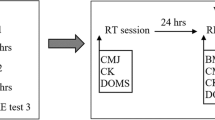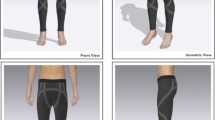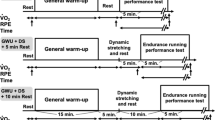Abstract
No previous studies have investigated the effect of lower body compression garments (CG) on running performance in the heat. This study tested the hypothesis that CG would negatively affect running performance in the heat by comparing CG and non-CG conditions for running performance and physiological responses in hot and cold conditions. Ten male recreational runners (29.0 ± 10.0 years, \( \dot{V}{\text{O}}_{ 2} \)max: 58.7 ± 2.7 ml kg−1 min−1) performed four treadmill tests consisting of 20-min running at first ventilatory threshold followed by a run to exhaustion at \( \dot{V}{\text{O}}_{ 2} \)max velocity in four conditions: 10°C with CG, 10°C without CG, 32°C with CG, and 32°C without CG (randomised, counterbalanced order). Time to exhaustion (TTE), skin and rectal temperature, \( \dot{V}{\text{O}}_{ 2} \), heart rate and rating of perceived exertion (RPE) were compared between CG and non-CG conditions at each environmental temperature. TTE was not significantly different between the CG and non-CG conditions at 10°C (158 ± 74 vs. 148 ± 73 s) and 32°C (115 ± 40 vs. 97 ± 33 s); however, there was a small (0.15) and moderate effect size (0.48), respectively, suggestive of an improvement in TTE with CG. Lower limb skin temperature was 1.5°C higher at 10°C with CG (P < 0.05), but no significant differences in other physiological variables, including rectal temperature, were observed between garment conditions. Interestingly, RPE was lower (P < 0.05) during submaximal running at 32°C with CG (13.8 ± 2.0) compared with non-CG (14.5 ± 2.7). It was concluded that CG had no adverse effects on running performance in hot conditions.




Similar content being viewed by others
References
Ali A, Caine MP, Snow BG (2007) Graduated compression stockings: physiological and perceptual responses during and after exercise. J Sports Sci 25:413–419
Aunola S, Rusko H (1984) Reproducibility or aerobic and anaerobic thresholds in 20–50 year old men. Eur J Appl Physiol 53:260–266
Bernard O, Ouattara S, Maddio F, Jimenez C, Charpenet A, Melin B, Bittel J (2000) Determination of the velocity associated with VO2max. Med Sci Sports Exerc 32:464–470
Bernhardt T, Anderson GS (2005) Influence of moderate prophylactic compression on sport performance. J Strength Cond Res 19:292–297
Berry MJ, McMurray RG (1987) Effects of graduated compression stockings on blood lactate following an exhaustive bout of exercise. Am J Phys Med Rehabil 66:121–132
Borg G (1982) Psychophysical bases of perceived exertion. Med Sci Sports Exerc 14:377–381
Bringard A, Denis R, Belluye N, Perrey S (2006a) Effects of compression tights on calf muscle oxygenation and venous pooling during quiet resting in supine and standing positions. J Sports Med Phys Fitness 46:548–554
Bringard A, Perrey S, Belluye N (2006b) Aerobic energy cost and sensation responses during submaximal running exercise positive effects of wearing compression tights. Int J Sports Med 27:373–378
Brownlie L, Mekjavic I, Basnister E (1987) Thermoregulation in athletic racing apparel. Ann Phys Anthropol 6:145–155
Colin J, Timbal J, Houdas Y, Boutelier C, Guieu JD (1971) Computation of mean body temperature from rectal and skin temperatures. J Appl Physiol 31:484–489
Desharnais R, Jobin J, Cote C, Levesque L, Godin G (1993) Aerobic exercise and the placebo effect: a controlled study. Psychosom Med 55:149–154
Doan BK, Kwon YH, Newton RU N, Shim J, Popper EM, Rogers RA, Bolt LR, Robertson M, Kraemer WJ (2003) Evaluation of a lower-body compression garment. J Sports Sci 21:601–610
Dupont G, Blondel N, Berthoin S (2003) Time spent at VO2max: a methodological issue. Int J Sports Med 24:291–297
Galloway SD, Maughan RJ (1997) Effects of ambient temperature on the capacity to perform prolonged cycle exercise in man. Med Sci Sports Exerc 29:1240–1249
Gavin TP (2001) Clothing fabric does not affect thermoregulation during exercise in moderate heat. Med Sci Sports Exerc 33:2124–2130
Gavin TP (2003) Clothing and thermoregulation during exercise. Sports Med 33:941–947
Hopkins WG (2003) A New View of Statistics. Retrieved 10/09/2009 from http://www.sportsci.org/resource/stats/index.html
Laursen PB, Knez WL, Shing CM, Langill RH, Rhodes EC, Jenkins DG (2005) Relationship between laboratory-measured variables and heart rate during an ultra-endurance triathlon. J Sports Sci 23:1111–1120
Lawrence D, Kakkar VV (1980) Graduated, static, external compression of the lower limb: a physiological assessment. Br J Surg 67:119–121
Margaria R, Cerretelli P, Aghemo P, Sassi G (1963) Energy cost of running. J Appl Physiol 18:367–370
Morgan DW, Martin PE, Krahenbuhl GS (1989) Factors affecting running economy. Sports Med 7:310–330
Parkin JM, Carey MF, Zhao S, Febbraio MA (1999) Effect of ambient temperature on human skeletal muscle metabolism during fatiguing submaximal exercise. J Appl Physiol 86:902–908
Pereira MA, Freedson PS (1997) Intraindividual variation of running economy in highly trained and moderately trained males. Int J Sports Med 18:118–124
Pontrelli GJ (1990) Comfort by design. Asian J Textile 21:52–61
Ramanathan NL (1964) A new weighting system for mean surface temperature of the human body. J Appl Physiol 19:531–533
Romer LM, Bridge MW, McConnell AK, Jones DA (2004) Influence of environmental temperature on exercise-induced inspiratory muscle fatigue. Eur J Appl Physiol 91:656–663
Scanlan AT, Dascombe BJ, Reaburn PR, Osborne M (2008) The effects of wearing lower-body compression garments during endurance cycling. Int J Sports Physiol Perform 3:424–438
Sperlich B, Haegele M, Achtzehn S, Linville J, Holmberg HC, Mester J (2010) Different types of compression clothing do not increase sub-maximal and maximal endurance performance in well-trained athletes. J Sports Sci 28:609–614
Stolwijk JAJ, Hard JD (1966) Partitional calorimetric studies of responses of man to thermal transients. J Appl Physiol 21:967–977
Author information
Authors and Affiliations
Corresponding author
Additional information
Communicated by Narihiko Kondo.
Rights and permissions
About this article
Cite this article
Goh, S.S., Laursen, P.B., Dascombe, B. et al. Effect of lower body compression garments on submaximal and maximal running performance in cold (10°C) and hot (32°C) environments. Eur J Appl Physiol 111, 819–826 (2011). https://doi.org/10.1007/s00421-010-1705-2
Accepted:
Published:
Issue Date:
DOI: https://doi.org/10.1007/s00421-010-1705-2




